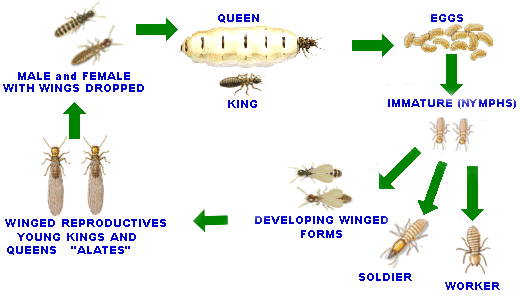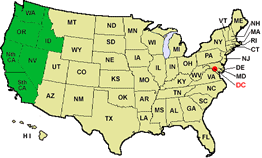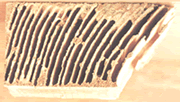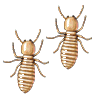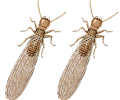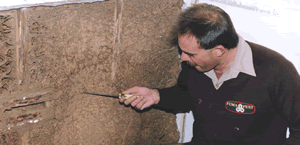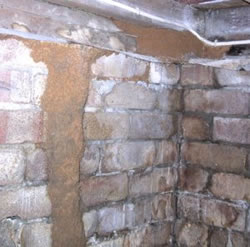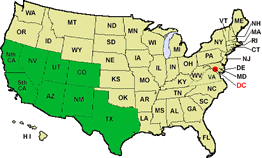|
|
| Destructive Termites in California |

| Identification of the main destructive species |
It is critical to identify the species of destructive termites to formulate
an appropriate control program. The main species of destructive
termites in California are:
CONTENTS: learn about destructive species of termites - tips on identification
of the timber damage - find out when they swarm in your
local area and how to identify the swarmers, workers and soldiers - learn
about their fascinating biology, life-cycle and behavioural aspects - and receive
professional tips on how best to protect your home from the world's best timber
recycler .... subterranean termites. |
| Western
subterranean termites |
| Identification of Timber Damage |
Western subterranean termites are highly destructive to douglas fir and
other common timbers used in the construction of a building. They can rapidly
eat out the internal sections of structural timbers - devouring mainly the
spring wood, and preferring to leave the harder summer wood sections.
As`a result, infested timbers are often left as a thin shell with a honey-comb
of layered hollow sections (as illustrated) packed with moist soil. |
| Western subterranean termites ... destructive nature
|
| The Western subterranean termite is a serious economic timber pest causing
millions of dollars of damage throughout the areas where it is located.
It is estimated that more than 1 in 5 homes in the high activity areas have
been or will be attacked at sometime by these voracious little insects. |
| The life-cycle of subterranean
termites |
| Biology of western subterranean termites |
Within a termite nest there are members of different castes, each with a
different role to perform and all interdependent upon each other for survival
of the colony. These include the queen, king, the winged reproductive (young
kings and queens), soldier and worker termites.
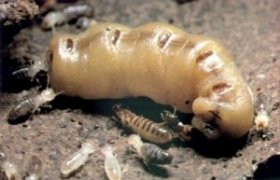
The king, queen and worker termites. |
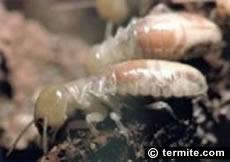
Worker termites - thin external skin. |

|
The queen termite is an egg laying machine; her body is enormous
compared to her off-spring; she can live more than 25 years and produce
more that 2,000 eggs a day. |
|
|
The king and queen live in a central chamber and are tended by
the workers. |
The workers are by far the largest
caste in the western subterranean termite colony and
the one that does the damage; they are a creamy translucent colour,
soft bodied and carry out all work in the nest, including gathering
food (timber and other cellulose); constructing tunnels; repairing
and enlarging the colony nest; grooming each other and feeding the
soldiers, the king, queen and also caring for the young nymphs until
mature.
IDENTIFICATION: Western subterranean worker termites are small in size, about half the size of
match-head or 1/8" long and are soft bodied insects. They have no wings, are sterile,
blind and work 24 hours a day for their entire 2 year life span.
|
The soldiers are the defenders of the
colony, particularly against marauding ants - with whom they have
engaged in a relentless war lasting 250 million years.
IDENTIFICATION: the soldiers have an
orange coloured rectangular armoured head with mandibulate pinchers which they use to crush the ants. On their forehead is a fontanelle
(frontal gland pore) used to emit a sticky latex to ensnare the ants.
The soldier termite is usually the first to be seen in large numbers
when any active termite workings (mud shelter tubes or damaged timber)
are opened. Soldier termites will rush out to guard the opening whilst
worker termites repair the breach. |
The swarmers (reproductives) are
called "alates"
and are commonly seen when they swarm during daylight; they have eyes; are poor fliers but are swept along by
the wind; they land, drop their wings, find a mate to become king
and queen of a new termite colony.
IDENTIFICATION: The western subteranean termite swarmers are about 3/8" long (including wings) with a dark brown
body and a small fontanelle (frontal gland pore) on its head. Their wings are brownish grey with two dark solid veins along the forefront
of the front wings. The front wing is distinctly larger than hind wing.
WHEN DO THEY SWARM? In the southern part of their range, swarming
takes place in the spring, but without rain. In the southern areas, swarming usually follows rain. The swarmers are emitted in their
thousands when a mature termite nest is large and well established.
Western subterranean termites swarm in large numbers over a wide area
to find a mate from another colony nest to start up a new colony.
A suitable location for nesting should provide moisture and a readily
available timber food source close by.
Colony nest development is slow in the first few months, with the
egg-laying capacity of the new queen termite peaking after a few years.The
swarmers are emitted in their thousands when a mature termite nest
is large and well established. Swarmers are usually produced after
this period and are an indication a large termite nest is in the vicinity,
a sure danger sign and a warning that professional protection is required.
The colony nests of Western subterranean termites are usually located
in the ground below the frost line, but above the water table. Mud
galleries or "shelter tubes" are constructed across hard
objects in order to gain access to timber food sources.
Western subterranean termites constantly search for new food sources.
They are known to enter buildings through cracks in concrete flooring
or to travel under parquetry or tile flooring through gaps of less
than 1/16" wide.
Where moisture regularly collects inside the wall or other cavities
of a building, say from faulty plumbing or broken roof tiles, the
Western subterranean termite can develop a subsidiary colony nest
which may not require contact with the ground to ensure it's survival. |
They build a central colony nest from
which they construct underground tunnels that radiate within a 100 yard
radius from a central colony nest in search of a timber (cellulose) food
source.
The picture on the left shows a termite inspector examining
an above ground termite subsidiary nest built inside a wall
cavity of a home.
Termites often build such nests if moisture is allowed to regularly
collects inside the wall cavity, say from leaking pipes, shower
recess, faulty plumbing, guttering, broken roof tiles, etc.
|
Termites travel in humidified mud-shelter tubes or galleries...
The picture on the left shows a mud shelter tube that subterranean
termites have constructed over a solid object, in this case,
a brick foundation wall in the sub-floor of a cottage.
Subterranean termites travel in these mud shelter tubes as protection
from predators, sun-burn, dehydration and to maintain a high
humidity environment which is essential for their survival.
Western subterranean termites are highly secretive, preferring
to enter a building through areas inaccessible to inspection,
such as, through in-fill patios, fire heaths, expansion joints
and cracks in concrete slab (on-ground) flooring.
Western subterranean termites can pass through a 1/8" crack
or an expansion joint (eating through the rubber compound) between
adjoining concrete on ground flooring. They can also travel
under parquetry and floor tiles to get to the wall framing timbers.
|
|
Only the worker termite caste can digest timber by the use of symbiotic
protozoa in their gut. Worker termites feed their partly digested semi-liquid
food, regurgitated from their mouth or passing from their anus, to the other
termites, a process known as trophallaxis.
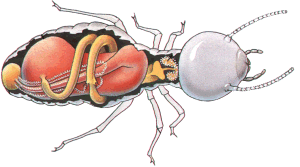
|
Western subterranean termites have a well ordered social system with
amazing engineering capabilities and an acute survival instinct; they
obtain moisture from the soil and moist decaying timber, and communicate
using pheromone signals.
The mutual feeding, constant grooming and close social habits
of termites are used to advantage in modern termite control
baiting systems. |
Certain hi-tech termite baits are now on the market that have a delayed
lethal effect on termites which readily pass on the bait to other termites
in the central colony nest during the mutual grooming and feeding.
 |
Western subterranean termites need to maintain a high level of humidity
and temperature (75 to 95F) in their central colony nest.
Western subterranean termites eat through the centre of susceptible
timbers leaving nothing but a thin veneer of timber and/or paint.
They will pack mud in cracks and joints in timber to prevent loss
of humidity and resultant dehydration. |
|
As noted above, termites constantly groom and feed each other. A valuable
technique for the termite controller is to instal and monitor a termite
baiting system next to any live activity found in and around the premises
where termite foraging is most likely to occur. Subsequent inspections (preferably
monthly) may reveal dead or sick worker termites, they change colour to
a mottle look, and spread of the termite bait to other termites leading
to elimination of the colony.
The termite baits are designed to be non-repellant to the termites and has
a unique delayed effect. Time enough to be passed onto the other termites
in the colony including the queen, with a sufficient dosage leading to the
elimination of the entire colony. This process is explained in detail in
the Termite Control section of this website. |
| If You find these termites do NOT disturb them |
Western subterranean termites have acute survival instincts. If they
are shaken up or disturbed, the termites often will abandon the associated
area and move on to secretly cause damage in other areas in the building.
If you find western subterranean termites in or around your property, it
is essential that you do NOT disturb them and promptly arrange for a professional
inspection and application of a termite bait to the live termites, if present
in abundance.
 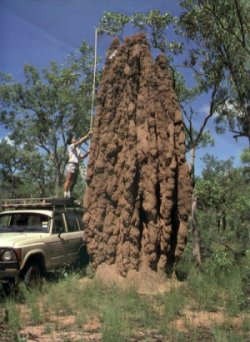 |
Subterranean Termites...
Mother Nature's most prolific builders
This picture shows a large above ground termite nest found in the
Northern Territory of Australia. In the USA, most of the destructive
subterranean termite species build their nest completely below ground
level.
A large colony in an urban environment is most often unseen, being
totally below ground level with a nest containing more than a million
termites - the damage can be devastating.
Find Out How to Protect Your Property
Click
on Subterranean Termite Control
|
|
Area
of Distribution:
The Western drywood termite
is found in the southwestern states, as far north as Sacramento, with
heavier incidence along the coastal areas.
The Western drywood termite
accounts for most of the drywood termite damage in Arizona, California, Colorado, Texas, Utah and Virginia.
Colonies contain up to about
2,000 termites. Severe damage may be caused by the presence of multiple-colonies.It
is easily transported outside these areas in infested furniture and other
timbers. This termite lives in timber with moisture content of less than
12%.
Drywood termites are often distributed
by human activity, commonly by transporting infested furniture, picture
frames, and wood to new areas. It has failed to become established in
such areas outside its normal southern and mostly coastal range.
Identification
of Swarmers and Soldiers:
Swarmers are about 1/2"
long including wings Their wings are 3/8" long. The head and pronotum
of the swarmer is an orange brown and its abdomen is dark brown. The front
wing has 3 dark, heavily hardened veins in the front portion.
The forehead of the soldier
slopes down gradually from top of head, head flattened to slightly rounded
in side view, and head orange to reddish brown with the eye spot whitish.
Soldiers have mandibles with unequal number of teeth on each member of
pair, and antenna with the third segment greatly enlarged and club-like.
Identification
of Timber Damage:
Although the colony development
is slow, severe structural damage may still be caused by the presence
of multiple-colonies. Drywood termites eat across the wood grain and create
chambers, or galleries connected by tunnels.
Their gallery and tunnel walls
are velvety smooth, and no soil is present. Generally, there are faecal
pellets present. They are hard, less than 1/32" long, elongate-oval
with rounded ends. One of the unusual distinctive signs of their faecal
pellets is that they have 6 concave sides.
Evidence of infestation include
swarmers, shed wings, piles of pellets, termite plugs that seal all openings
in infested wood, and surface blisters caused by older, enlarged galleries
very close to the wood surface.
Biology
and Habits:
Drywood termites are
considered non-subterranean termites, as they do not live in the ground,
require no ground contact, and do not build mud shelter tubes.
They are more likely to be in
a structure made completely of wood with poor workmanship demonstrated
by poorly fitted corner joints. The termites typically inter the ends
of wood and seldom enter the sides of the section in question.
Their colonies are located in
the wood they eat and are generally small in size when compared to subterranean
termite colonies. The colony usually numbers about 3,000 individuals after
over 10 to15 years. A distinctive indication is no presence of a worker
caste and the nymphs perform all tasks typically done by workers.
After the mating flight, they
seek cracks or knotholes in nearby wood and chew a small tunnel which
they close then excavating a chamber after which they mate. After 3 year
to 4 years the colony may consist of up to 1,000 members.
The first swarmers may be released
when the colony is approximately 4 years old. Swarming typically takes
place about midday on sunny, warm (80°F) days, with the peak of the
swarm occurring shortly after a sudden rise in temperature. It typically
occurs during September and October. Swarmers
usually number in the dozens, occasionally the hundreds. Night swarmers
are attracted to lights.
Swarming drywood termites fly
into structures and infest wood directly. When swarming, they often reinfest
the same structure. They typically first infest exposed wood such as window/door
frames, trim, eaves and attics. They do so by finding a protected crevice
or other area, such as the joint between 2 pieces of wood, where shingles/paper
overhang timber or moulding, etc., and then attack the wood.
|
| Pacific
dampwood termites |
Area of Distribution: The Pacific dampwood termite is the
largest and most significant dampwood termite in the United States. They
have been found up to 6,000 feet above sea level, but more commonly in
the cool and humid coastal areas.
Identification of Swarmers and Soldiers: Swarming may occur throughout
the year, but most often from August through October. Swarming usually
will occur on warm humid evenings just before sunset. The reproductives
are strongly attracted to light. Swarmers are up to 1" in length
and are light to medium brown with dark brown wings.
Soldiers have a large head armed with long black toothed mandibles. The
anterior portion is black generally shading to a dark reddish-brown in
the posterior position. The abdomen and thorax are a light caramel color,
the abdomen varying according to the stomach contents at the time. The
largest termites in the United States, soldiers may be very large, reaching
5/8 to 3/4".
Identification of Timber Damage: The tunnels vary greatly in size and
shape and in sound timber may favour the softer springwood. Faecal pellets
are found throughout the tunnels, and are hard small, oval and about 1/25" long. The color of the pellets may vary according to the type
of wood being consumed.
Biology and Habits: This species will attack wood of all types throughout
its range. Timbers in contact with the soil or structures built near or
over water are common targets. This species is known to be very tolerant
of moist conditions, even being found in pilings subject to tidal flooding.
Colony size varies but may contain as many as 4,000 individuals.
Colony growth is aided by the production of secondary reproductives. Like
other termites this species aid in the spreading of wood decay fungi,
the spores of which are carried in the gut and on their bodies. A well
established colony will produce winged reproductives which may infest
nearby timber.
The life history of the Pacific dampwood can be summarized as follows.
Both male and female swarmers excavate a chamber, they enter, and the
chamber is sealed. They mate and within about 2 weeks, eggs are laid and
the colony is founded. The queen lays about 12 eggs. The second batch
is laid the next spring.
|
| Published by Fumapest Group © copyright 1995
-
|
|
